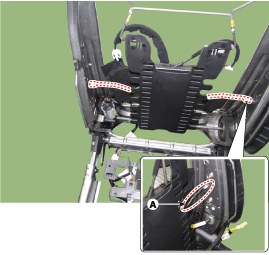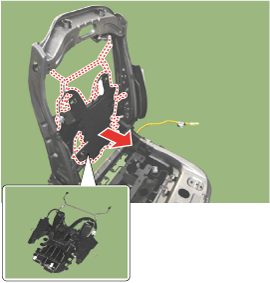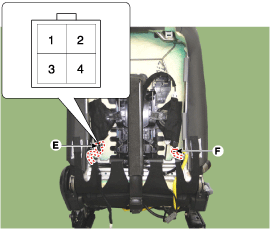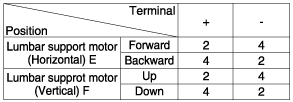Hyundai Sonata LF: Seat Electrical / Lumber Support Units Repair procedures
Hyundai Sonata LF 2014-2019 Service Manual / Body Electrical System / Seat Electrical / Lumber Support Units Repair procedures
| Removal |
| 1. |
Disconnect the negative (-) battery terminal. |
| 2. |
Remove the front seat assembly.
(Refer to Body - "Front Seat Assembly") |
| 3. |
Remove the seat back.
(Refer to Body - "Front Seat Back Cover") |
| 4. |
Disconnect the lumbar support motor connector (A).
|
| 5. |
Remove the lumbar support assembly after disengaging mounting clip (A).
|
| Installation |
| 1. |
Install the lumbar support assembly. |
| 2. |
Install the seat back cover. |
| 3. |
Install the front seat assembly.
|
| Inspection |
Diagnosis with GDS
| 1. |
The body electrocal system can be quickly diagnosed failed parts with vehicle diagnostic system (GDS).
The diagnostic system (GDS) provides the following information.
|
| 2. |
Select the "Car Model" and the system to be checked in order to check the vehicle with the tester. |
| 3. |
Select the "Power Seat Module (PSM)" to check the power seat module (PSM). |
| 4. |
Select the "Current Data" menu to search the current state of the input/output data.
The input/output data for the sensors corresponding to the power seat module (PSM) can be checked. |
| 5. |
If you will check the power door lock operation forcefully, select "Actuation Test". |
Lumbar Support Motor
| 1. |
Disconnect the connectors for each motor.
[Lumbar Support Motor]
|
| 2. |
With the battery connected directly to the motor terminals, check if the motors run smoothly. |
| 3. |
Reverse the connections and check that the motor turns in reverse. |
| 4. |
If there is an abnormality, replace the motors.
|
Other information:
Hyundai Sonata LF 2014-2019 Service Manual: Rear Door Curtain Assembly Repair procedures
Replacement Put on gloves to protect your hands. • When prying with a flat-tip screwdriver or use a prying trim tool, wrap it with protective tape, and apply protective tape around the related parts, to prevent damage...
Hyundai Sonata LF 2014-2019 Service Manual: Power Window Switch Description and Operation
Description System Diagram Driver Door Module (DDM) Driver Door Module (DDM) is part of CAN configuration, communicating with BCM, SMK, SJB, PSM, and ADM via CAN while performing wired signal I/Os with safety power windows. Operate the buttons of DDM located on the inner side of the driver door to perform any functions related to power windows, electric mirror, and door lock/unlock...
Categories
- Manuals Home
- Hyundai Sonata Owners Manual
- Hyundai Sonata Service Manual
- Timing System
- Lubrication System
- Audio
- New on site
- Most important about car
Copyright © 2025 www.hsonatalf.org








